Welcome to our Colossus Movie Guide for The Batman. This guide contains everything you need to understand the film. Dive into our detailed library of content, covering key aspects of the movie. We encourage your comments to help us create the best possible guide. Thank you!
What is The Batman about?
The Batman is a movie all about catharsis and rebirth. When Thomas Wayne was murdered, the Renewal Project—which was aimed at removing the governmental red tape that prevents meaningful legislation from being passed—died with him. Corruption and greed took Gotham by hold, sending the city into a downward spiral of crime and immorality. Bruce Wayne—deeply traumatized by his father’s death—wants to continue his father’s legacy, but takes a different route. Desperate to avenge his father, Bruce decides to become The Batman and clean up Gotham himself.
But by hiding behind a mask and becoming obsessed with revenge, Bruce doesn’t realize he is removing the “Wayne” of his father’s legacy from the equation. Vengeance becomes his driving motive, which causes him to lose sight of humanity, of his father’s mission, of himself. Thus, the revival of the Renewal Project comes to parallel Bruce’s rebirth into the world. Bruce must learn to be patient and understanding of both others and himself—he can’t fix the world’s problems until he finds spiritual peace. By learning to strike that balance between compassion and vengeance, he’s ready to make meaningful change in the city of Gotham, and he’s able to find his true identity—he’s ready to become The Batman.
Movie Guide table of contents
Cast
- Robert Pattinson – Bruce Wayne / Batman
- Zoë Kravitz – Selina Kyle / Catwoman
- Paul Dano – Edward Nashton / Riddler
- Jeffrey Wright – James Gordon
- John Turturro – Carmine Falcone
- Peter Sarsgaard – Gil Colson
- Andy Serkis – Alfred Pennyworth
- Colin Farrell – Oswald “Oz” Cobblepot / Penguin
- Jayme Lawson – Bella Reál
- Peter Craig – Writer
- Matt Reeves – Writer and director
The ending of The Batman explained
A recap of The Batman‘s ending
At the end of The Batman, Bruce leads survivors through a flooded building and back out into the streets. With much of the roads underwater and a rebuild process underway, Bruce reads this diary entry as we watch him help people find comfort in the mess:
Wednesday, November 6th. The city is underwater. The national Guard is coming. Martial law is in effect, but the criminal element never sleeps. Looting and lawlessness will be rampant in the parts of the city no one can get to. I can already see that things will get worse before they get better. And some will seize the chance to grab everything they can. I’m starting to see now: I have had an effect here…but not the one I intended. Vengeance won’t change the past—mine or anyone else’s. I have to become more. People need hope. To know someone’s out there for them. The city’s angry, scarred—like me. Our scars can destroy us. Even after the physical wounds have healed. But if we survive them, they can transform us. They can give us the power to endure…and the strength to fight.”
During that monologue, Bella Reál gives this speech to a crowd: “We will rebuild. But not just our city. We must rebuild people’s faith in our institutions, in our elected officials, in each other. Together, we will learn to believe in Gotham again.”
We then cut to Riddler in jail. He moans and cries, tortured by his foiled plan. Then from another cell, we hear another man speaking to Riddler—a man we’ll soon learn is The Joker. He says: “Isn’t that just terrible. Him…raining on your parade like that? What is it they say? One day you’re on top…the next, you’re a clown. Well…let me tell you, there are worse things to be. Hey, hey, hey. Don’t be sad. You did so well. And you know, Gotham loves a comeback story.”
“Who are you?” Riddler asks.
“Well, that’s the question, isn’t it? Riddle me this: the less of them you have, the more one is worth.”
“A friend,” Riddler answers. They both starting laughing maniacally.
We then cut to Selina and Bruce standing on a ledge next to their motorcycles. Selina asks Bruce to run away with her. “You know this place is never going to change,” she says to Bruce. “With Carmine gone, it’s only going to get worse for you. There’s going to be a power grab. It’ll be bloody.”
“I know,” responds Bruce. “But the city can change.”
“It won’t.”
“I have to try.”
“It’s going to kill you eventually. You know that.” Selina then steps towards Batman and says, “Listen. Why don’t you come with me. Get into some trouble. Knock off some CEO hedge fund types. It’ll be fun. The cat and the bat. It’s got a nice ring.”
Bruce then turns his gaze to the sky, and Selina turns to see the bat signal resting in the clouds. “Who am I kidding,” she says. “You’re already spoke for.”
Selina then rides off on her motorcycle, and she’s soon followed by Bruce. They ride together through a graveyard, over a bridge, and onto a road. When they reach an intersection, they part ways—Selina away from the disarray of Gotham, and Bruce back in to try and fix it.
The meaning of The Batman‘s ending
Several things happen here at the end. The conversation between Riddler and The Joker is likely in service of the plot for the sequel, as we can assume they will both escape from prison and wreak havoc on Gotham. But altogether, everything that happens at the end of The Batman is in service to Bruce’s journey and the thematic meat of the film (with Bella Reál’s speech serving as a societal extension of his storyline).
As Chris will discuss in the themes section, renewal is the biggest theme of The Batman. Bruce’s motives for becoming Batman are vengeful, as he seeks to punish the criminals of Gotham that he blames for his father’s death. But Bruce’s journey also involves a sort of rebirth—similar to the renewal that Gotham must undergo to find peace. Thomas Wayne’s Renewal Project may be dead, but Bruce can continue his father’s legacy in his own way. Bruce can be a judicious superhero while still remaining compassionate and social human being. By ceasing his hermit ways and becoming a member of Gotham, he can enact real, meaningful, lasting change.
In many ways, this journey reflects the current state of the world. Society is torn apart by politics and ideology. People feel cheated and burned, and thus become vengeful about those whom they perceive as “others,” those who have reap more benefits of society. This mentality drives malicious and mean-spirited sentiments that become part of the zeitgeist and define the culture.
But The Batman argues that you don’t have to fall prey to such negativity. You can stave off such cynicism and find your own inner peace; you can emit a comforting voice amidst the clutter that reaches people and gives them comfort, gives them hope. An empathetic ear, a compassionate and understanding tone can bring people together. Individually, we can do our parts in fixing such a monumental mess.
All three of the above scenes speak to that. We hear Bruce verbally confirming this journey as he helps people; then the Riddler and Joker (as well as Penguin, whom we see during Bruce’s monologue) represent the ugly, undeniable reality—they all speak to the inescapable evil and destruction that awaits around every corner, that will continue to tempt the worst parts of our being; and finally, Selina represents the ability to turn a blind eye, to remain silent, to live your life in solitude as the world rips itself apart.
All of these endings perfectly set up another Batman movie. After this arduous journey, will Bruce be able to keep a focused gaze? Can he remember what his father was fighting for and keep positive energy? Or will evil or passivity win out?
The themes and meaning of The Batman
“Renewal” is one of the big topics in The Batman. Plot-wise, The Renewal Project is the legislative legacy of the late Thomas Wayne, Bruce’s father, and has defined Gotham’s political landscape for decades. But the concept of renewal goes deeper than a plot point. It’s actually the thematic core of the entire film.
I’ll explain.
First, let’s take a step back and look at the focus of Matt Reeves’s The Batman.
Focus 1: Bruce Wayne
Focus 2: Gotham
In the universe Reeves created, Gotham and Bruce (Robert Pattinson) were both promising and hopeful until the death of Thomas Wayne (Luke Roberts). After that, the child and the city spiraled into darkness. The Batman picks up 20 years later and the darkness has taken hold.
Gotham is full of crime. The crime lord Carmine Falcone is the one who actually controls the political affairs. The mayor, the DA, the police commission—they all report to Falcone.
And Bruce is, well, not doing well. He’s disassociated to the point where he barely makes appearance as Bruce Wayne. He’s lost himself in Batman. In the idea of being “vengeance.” His grief is an open wound and it drives him to try and save the city that stole his father and mother (Stella Stocker) from him. While he’s doing good, or trying to do good, it’s motivated by his unresolved issues, an agony he’s unable to quiet.
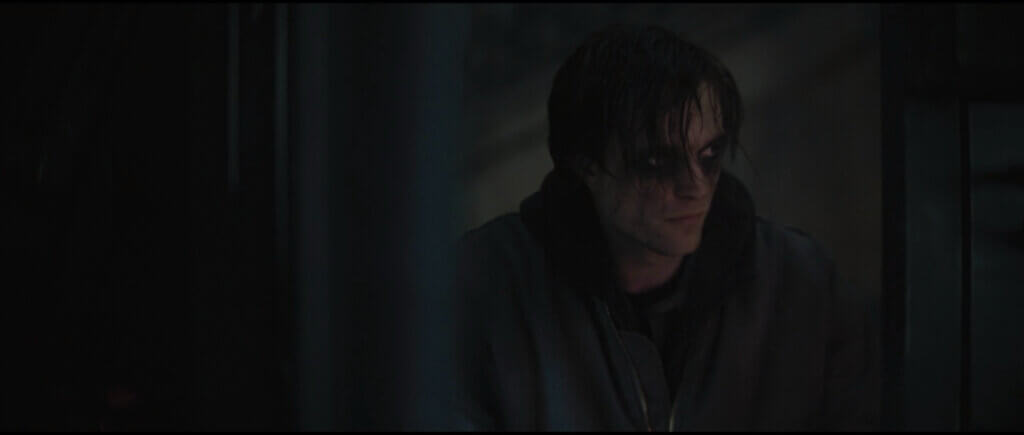
That’s the set-up. A hero and a city who can both be more than they currently all but are both burdened by their past. In narrative, what you typically want to do is establish a state of being, on both the personal (Batman) and public (Gotham) levels.
You can see the same thing in Star Wars. Personal: Luke has great potential. Public: The galaxy is ruled by the evil forces of the Galactic Empire.
Or The Matrix. Personal: Neo is searching for more meaning to his life. Public: Machines have enslaved human minds in a digital world called The Matrix.
Apocalypse Now. Personal: Willard mentally struggles to deal with being a soldier in the Vietnam War. Public: The Vietnam War is driving American soldiers crazy.
Black Swan. Personal: Nina wants to be a star ballerina. Public: There’s a new, major performance of Swan Lake about to happen.
Once you have the personal and public state of being set-up, a narrative usually resolves by contrasting or accelerating that initial state of being. Resulting in either a happy ending, a gray ending, or outright tragedy.
Star Wars: Luke lives up to his potential and defeats the Galactic Empire.
The Matrix: Neo ends up being The One and starts to free people from The Matrix.
Apocalypse Now: Willard confronts then puts and end to Colonel Kurtz, the craziest of crazed soldiers. He’s accomplished his mission, but at what cost?
Black Swan: Nina becomes the new Swan Queen and gives a career-defining performance, but it drives her crazy and causes her to take her own life in pursuit of a single, perfect performance.
The Renewal Project
In The Batman, Thomas Wayne’s Renewal Project (or Renewal Fund) was a fund donated to the city that was supposed to transcend the red tape of government. Usually, the city has to put things through committees and get approvals and yada yada. Simple things can take months. Major things can take years. The goal of Renewal was to fund all of these things quickly and fully. When Thomas Wayne was alive, it worked. It built the seawall. It funded the orphanage Riddler (Paul Dano) grew up in. It helped the develop and stabilize Gotham during Gotham’s rise to prominence.
Then Falcone killed Thomas Wayne. Without Wayne’s oversight, the fund began to go to “projects” that were actually just fronts for enriching criminals and shady officials. Donate $500,000 to repair city streets. $250,000 of that goes to purchasing supplies from a company called Not Carmine. Carmine then never follows through with the supplies, the city never follows through with the repairs, but suddenly the mayor, police commissioner, and district attorney are each $50,000 richer.
Actually important things, like Riddler’s orphanage, fell by the wayside. This is what Riddler meant when he said and painted, “Renewal is a lie.”
Eventually, Bruce realizes the legacy of Renewal and his own culpability. He’s the only one who could do anything about the fund. It’s his family’s money. It’s his money. Instead of realizing and accepting that, he let the vultures and hyenas devour the fund while everyone else suffered. This is partially what Riddler meant by “The Sins of the Father” in his critiques of Bruce.
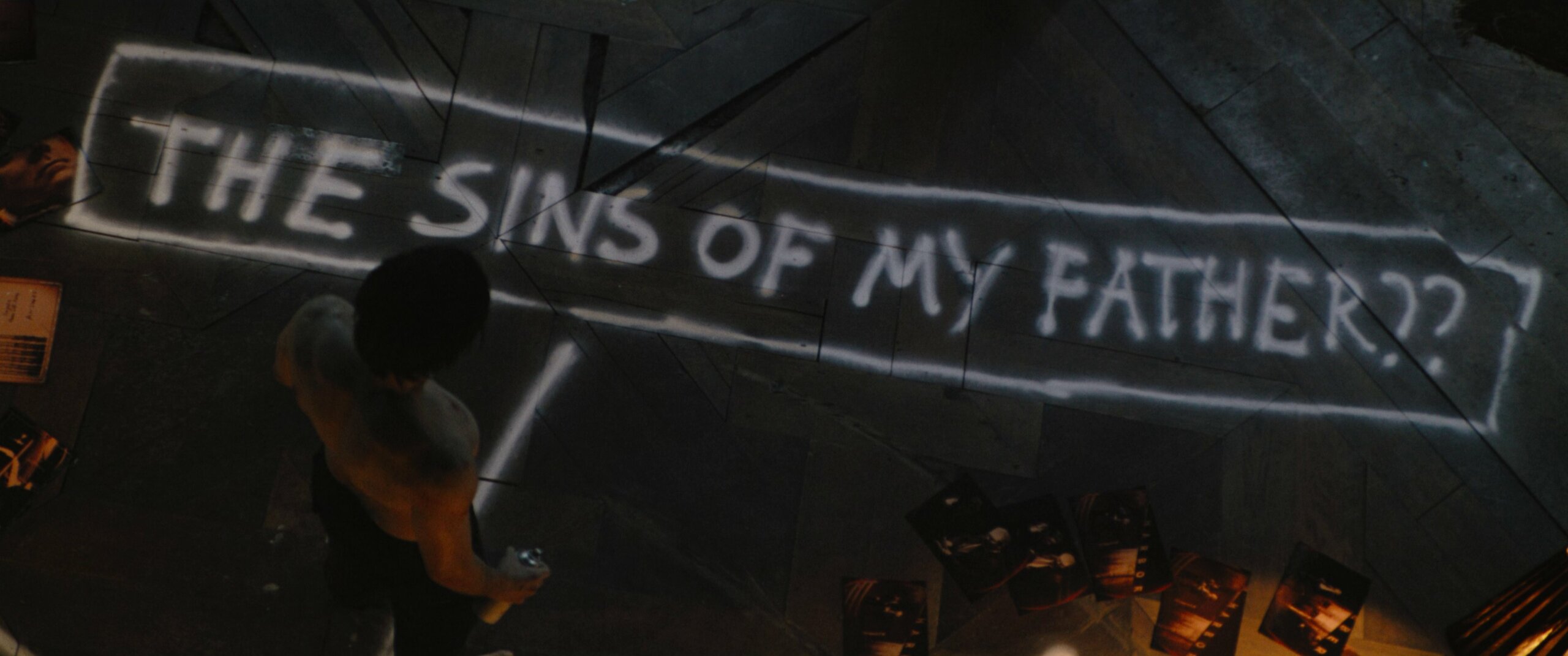
The Symbolism of Water
Water is universally associated with renewal and rebirth, with purification and restoration. Just look at the Christian act of baptism—you dunk someone in water to symbolize the cleansing of their soul.
Look at The Truman Show. Jim Carrey’s character, Truman Burbank, is the unknowing star of a life-long reality TV show. Everything in his life has been scripted. But he doesn’t know it since he was born into this. His family. His wife. His neighbors. Friends. All actors. Hidden cameras are everywhere and broadcast 24/7. The story establishes all of this. Then builds to Truman figuring things out and trying to escape. To escape, he sails a boat out to “sea.” The show’s producer and kind-of-literal God of the world, causes an artificial storm that throws Truman from the boat.
Truman had always been afraid of water. So this is his nightmare scenario. His biggest fear. Of course, he falls from the boat, into the water, where he almost drowns. But he swims back. Fights his way to the deck. And sails to the end of his world. The false horizon of clouds and sky that’s really just a wall with a staircase. The movie ends with him walking up the stairs and out the exit.
It’s subtle, but the fall into water is a kind of baptism for Truman. It symbolizes him overcoming his old life. When he arrives at the stairs, he’s a new man. Ready to live real life for the first time.
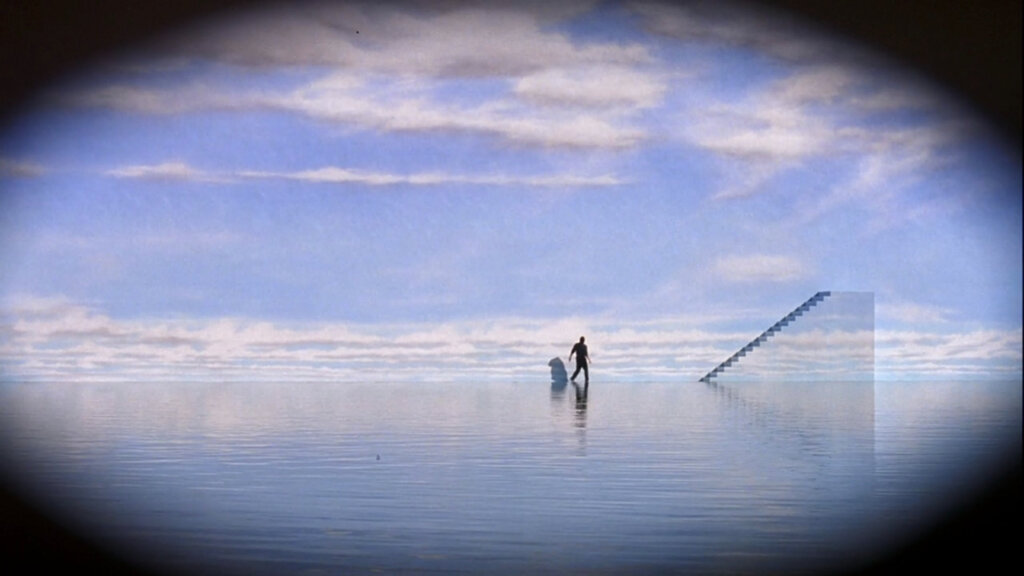
True Renewal
Hopefully you can see where this is going and how it explains the end of The Batman.
It’s not just a random choice by Matt Reeves to have Riddler blow the seawall and flood Gotham. It does make for cool visuals. It is a unique way to threaten the entire city and elevate Riddler from minor maniac to major psychopath. But it’s also the beginning of the thematic renewal of both Gotham and Batman.
There’s initially turbulence and danger and chaos, especially with the Riddler army who shows up, trying to take out the people seeking refuge in the Gotham Square Garden, including the new mayor-elect (Bella Reāl (Jayme Lawson). We get a team effort from Batman, Catwoman (Zoë Kravitz), and James Gordon (Jeffrey Wright). It all seems good until a power line threatens to fall to the arena floor and electrocute hundreds of people.
This is the symbolic moment. Batman jumps onto the power line and cuts it, neutralizing the electric threat. But doing so causes him to plummet into the water below. This plunge is his baptism. His renewal.
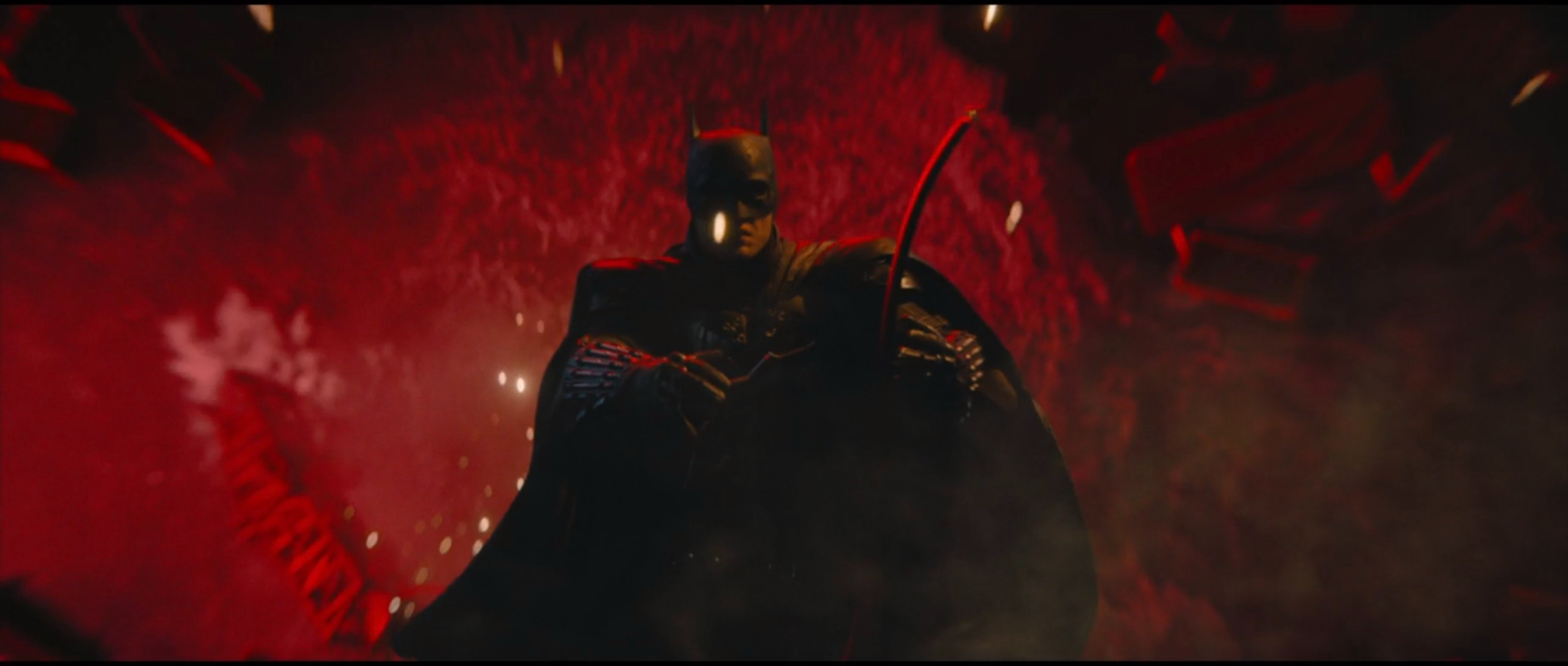
When he rises up, he’s no longer the vengeance-seeker who began the movie. He’s reborn into a protector. A guardian. Illustrated by how he wades through the water to help free the new mayor and the family of the old mayor, including the old mayor’s young son.
This is the third time Bruce interacts with young Don Mitchell Jr. (Archie Barnes).
The first time is after Riddler murders Don Mitchell Sr., the initial mayor of Gotham. Batman, as he leaves the crime scene, sees Jr. sitting with police. And there’s a long beat as Batman watches the boy. And you know what Batman is thinking: that was me. Jr. is in the same position Bruce was 20 years earlier. The child of a mayor who was killed.

The second time is at Sr.’s funeral. When the district attorney drives a car into the church, Bruce saves the kid by pulling him out of the path of the oncoming vehicle.
So we have the initial identification. Then the effort to save the boy, which is psychological a wish to save himself. And, finally, he leads Mitchell Jr. and the others out of the darkness of the now powerless stadium. Batman is, in this way, no longer portrayed as vengeance. Rather, he’s become the torch-bearer who will become a beacon to inspire others and show them the way forward.
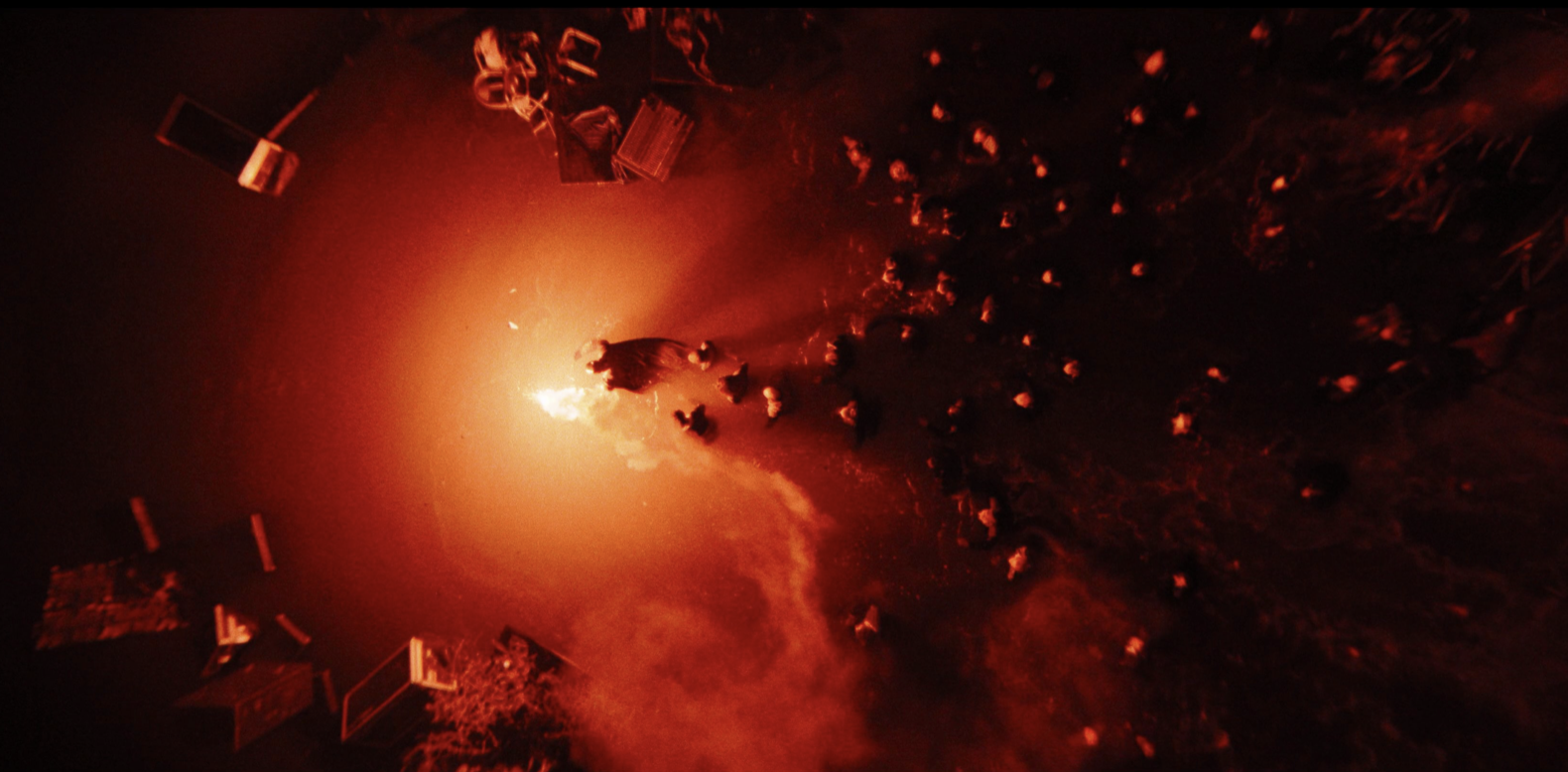
I think that bears repeating in less-poetic terms.
The Batman sets up the child of the deceased mayor as representative of Bruce’s past. Ultimately, Bruce rescues the kid and leads him through water and out of darkness.
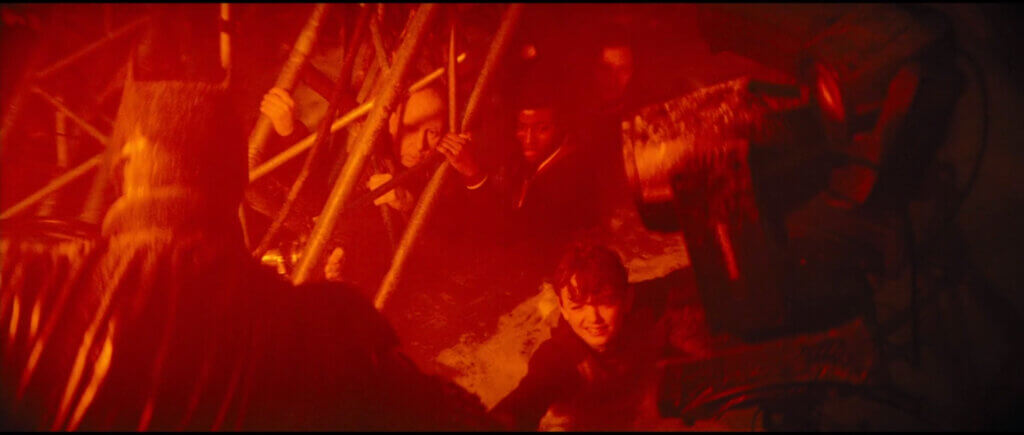
The other key moment is when one of the Riddler Army goons says “I’m vengeance” to Batman. That happens right before the power line fall into baptism. And it’s this “Oh no” moment for Bruce as that’s the exact phrase he was saying to criminals. It had been his mantra. The embodiment of what Batman represented. And to hear his words come out of the mouth of a murderous terrorist…that’s revelatory. Bruce realizes his negative, pain-inspired attitude did the city no favors. Did him no favors. And was inspiring the wrong kind of behavior.
Which is even more punctuated in the scene before the flood when Riddler has his whole speech where he truly believed he and Batman were working together, much to Bruce’s dismay.
So you have the movie showing us the terrible path Batman and Bruce could go down. Who they could become. Followed by the “renewal” of the water and walking out of the darkness.
That’s why we get that scene of him in the morning, helping police and EMTs, being part of the solution rather than simply indulging in violence. And of course, we get a speech.

“Wednesday, November 6th. The city is underwater. The national guard is coming. Marshal law is in effect. But the criminal element never sleeps. Looting. And lawlessness will be rampant in the parts of the city no one can get to. I can already see, things will get worse before they get better. And some will seize the chance to grab everything that they can. I’m starting to see now. I have had an affect here. But not the one I had intended. Vengeance won’t change the past. Mine or anyone else’s. I have to become more. People need hope. To know someone’s out there for them. The city’s angry. Scarred. Like me. Our scars can destroy us. Even after the physical wounds have healed. But if we survive them, they can transform us. They can give us the power…to endure. And the strength to fight.
Add to that Bella Real’s speech that comes in the middle of Batman’s own:
“We will rebuild. But not just our city. We must rebuild peoples’ faith. In our institutions. In our elected officials. In each other. Together, we will learn to believe in Gotham again.”
You have Batman literally comparing himself to the city. And Bella talking about rebuilding and believing again.
So The Batman isn’t the transformation of Gotham or Batman. Rather, it’s the renewal of the spirit. The renewal of faith. The renewal of hope. It’s the beautiful first step of an important process.
You would expect The Batman sequel to focus, then, on the changes that follow. Like Bruce Wayne becoming more of a presence in the city. Establishing Wayne Industries/WayneCorp/Wayne Enterprise. Becoming a popular, active figure. While Batman also shifts his approach. From one that selfishly sought violent conflict to one that promises a better tomorrow.
Hopefully we get a sequel.
Why is the movie called The Batman?
The answer to this question might seem super obvious. But of all the Batman movies, The Batman probably has the most meaningful title. The definite article of “the” changes everything.
Think about the original Batman. Made in 1989 by Tim Burton, the first Batman movie’s title needed to be direct. Everybody knew about the Batman comics and the Batman TV show, so the very first Batman movie needs to carry the aura of Batman—plain and simple. From there, the next two sequels—Batman Returns and Batman Forever—simply add to the mystique with buzzwords. Then Batman & Robin introduces a new character.
Christopher Nolan then goes the origin story route with Batman Begins. That title announces the start of a new saga, leading to The Dark Knight and The Dark Knight Rises. That series was named after Frank Miller’s 1986 The Dark Knight Returns comic books, and those stories portrayed a much darker, more serious version of the Batman lore than the first four Batman movies—hence the grimmer title.
Batman vs. Superman: The Dawn of Justice is another simple title that blatantly captures what the movie is about, as Batman and Superman fight in the beginning. The addition of The Dawn of Justice marks a new era after Batman and Superman team up in the end. Justice League is even more straightforward.
But The Batman offers a twist on the origin story. Bruce Wayne is not Batman, but the Batman. That title has a very specific energy, and almost downplaying the mythology of Batman. It makes him seem more human. Without the definite article, “Batman” feels immortal, enduring, everlasting. But when you say “the Batman,” it becomes very specific—like he’s just some local nut job who dresses up as a bat and beats up criminals.
And that energy is conveyed at the beginning of the movie. Criminals are scared of a mysterious man who randomly shows up to fight; the police are wary of this local tough who dresses as a bat. He is an unknown entity, somebody who’s just starting out, who’s trying to find their footing, their identity.
It’s important for Batman to be undefined at the beginning of The Batman because Bruce doesn’t even know who Batman is until the very end. At the beginning of the movie, Bruce’s only motive for becoming Batman is retaliation—he wants to punish the criminals of Gotham for killing his father. He is filled with anger and frustration, leading him to roam Gotham’s streets with hatred and investigate criminals with vengeance, with malice, with cruelty.
Fittingly an original working title of the film was Vengeance—but that title would have only worked for the first two-thirds of The Batman.
The great thing about this movie is that Bruce tweaks his motives. After his father’s death, Bruce became sullen and was driven by hate. But that energy completely combatted what his father was all about. Thomas Wayne was a beacon of hope for Gotham, as he sought to use his wealth to improve government and clean up the streets. His motives were altruistic. Once Bruce realizes that he can carry his father’s energy while fighting crime, he then becomes spiritually centered. No longer driven by hate at the end of the movie, Bruce finds balanced perspective and resembles a human being once again—he truly becomes the Batman. With a more defined mantra, Bruce is ready to become part of the Batman lore and rebuild his version of Gotham.
Important motifs in The Batman
Perception and identity
Identity is obviously a relevant motif in any Batman movie, as Batman’s identity remains hidden to the public. But perhaps more than any other Batman movie, Bruce’s perception of his own identity in The Batman is of utmost importance.
During Batman’s introduction, Bruce reads this menacing diary entry:
Thursday, October 31st. The city streets are crowded for the holiday. Even with the rain. Hidden in the chaos is the element, waiting to strike like snakes. And I’m there too. Watching. Two years of nights have turned me into a nocturnal animal. I must choose my targets carefully. It’s a big city. I can’t be everywhere. But they don’t know where I am. We have a signal now, for when I’m needed. When that light hits the sky, it’s not just a call—it’s a warning. To them. Fear is a tool. They think I’m hiding in the shadows. But I am the shadows. I wish I could say I’m making a difference, but I don’t know. Murder, robberies, assault—two years later, they’re all up. And now this. This city’s eating itself. Maybe it can’t be saved, but I have to try—push myself. These nights all roll together in a rush behind the mask. Sometimes in the morning I have to force myself to remember everything that happened.
From this, the only perception we and others have of Batman is one of fear and unease. He is out to hurt the people that harmed him and his family. This plays into Riddler’s perception of Batman, as he sees Bruce as an ally—someone who scares others with an iron fist. Bruce is flabbergasted that Riddler owns this view of Batman. But really, Riddler’s perception of Batman isn’t so outrageous, given Bruce’s behavior and mentality.
This represents a turning point for Bruce, who must channel a different sort of energy to fix the city of Gotham. The only way to inspire hope in Batman is to overpower the vengeance and negativity, to bring some humanism to his superhero figure. Bruce can’t change others’ perception of his identity until he changes his own self-perception.
Father figures
At three different points throughout the movie, Bruce shares a gaze with Gotham Mayor Don Mitchell Jr.’s son. The son is dealing with the trauma of his father’s gruesome murder as Batman tries to discover the Riddler’s identity. In effect, Bruce becomes a sort of father figure that ostensibly brings comfort to the young boy and allows Bruce to find catharsis.
This motif is born from Bruce’s own trauma, as he too lost his father as a young boy. Thomas Wayne was a prominent political figure in Gotham and aimed to rebuild the city with his Renewal Project. But after his death, Bruce became vengeful. Despite his father’s altruistic notions, Bruce adopted a cruel mindset and sought to punish the criminals of Gotham. He carried this negativity for most of his life.
But Bruce goes on a journey that soften his worldview, that allows him to observe the inherent goodness of his father’s mantra. Vengeance can turn a person ugly and spiteful, but hope can inspire meaningful change. By the end of the movie, Bruce realizes that he must become a force of good and positivity. He can still clean up the streets as Batman, but he can’t lose sight of himself, of what his father set out to do.
Thus, Bruce represents that beacon of hope to Mitchell’s son. The first two times Bruce sees this boy, they are both at a loss: Bruce cannot stop criminal mayhem from spreading, and the boy is forlorn over his father’s death. But the third time they interact—which is at the very end of the movie, when the streets have flooded and people are desperate for help—Bruce reaches out his hand and leads the boy out of the darkness.
This boy might have grown up just like Bruce—angry at the world and antagonistic towards others. But this ending carries optimism with it. Bruce isn’t this boy’s father, but he can serve a positive fatherly role in Mitchell’s absence. By being attentive of this boy’s needs, Bruce is able to find his own emotional catharsis and address his own father issues.
Questions & answers about The Batman
Did Riddler know Bruce Wayne is Batman?
Chris answers this question in extensive detail here.
Who killed Bruce Wayne’s parents?
This question is frustrating because there is no clear and concrete answer provided by the movie—something that was likely done on purpose to set up Bruce’s emotional journey in the sequel. Falcone suggests that his rival crime lord Salvatore Maroni ordered the hit, while Alfred believes Falcone was responsible. This air of secrecy and implication hovers over the end of the film. Because of it, we can assume Maroni will be a character in the next film and provide more clues for Bruce.
By the end of The Batman, finding out who killed Bruce’s parents almost doesn’t matter. In his journey in the film, Bruce finds balance in his life and learns to curtail his taste for vengeance and focus on improving the city by becoming a symbol of hope. He ends the movie on an uplifting note, ready to become a new man. The mystery surrounding his parents could draw him back to the dark side in the sequel, however—there will be a cloud of mistrust that looms over Bruce as he tries to find balance in his life. That’s likely why we don’t receive a definitive answer to this question in The Batman.
Now it’s your turn
Have more unanswered questions about The Batman? Are there themes or motifs we missed? Is there more to explain about the ending? Please post your questions and thoughts in the comments section! We’ll do our best to address every one of them. If we like what you have to say, you could become part of our movie guide!

Yeah, no way.
Batman says it himself. He’s trying to help Gotham with violence and Vengeance, which I guess is “wrong”… but he’s trying to help Gotham.
So this idea of him after the events of the movie REALIZING that “helping without violence but being the solution” just doesn’t work.
First: He WON’T do that. He CAN’T do that. Not as Batman. That kind of help, he can make it happen as Bruce, which the movie ignores.
And even if he could do that, he was two years beaten criminals up, and yet people feared him, but not Gordon? So why is Gordon the only one knowing pretty well he wasn’t hurting non criminals? Also, Bruce BECOMES BATMAN TO HELP GOTHAM… the trauma (vengeance) is always the fuel, but he the whole Batman thing would only make sense if he actually wants to help.
And again, realizing that he can “help without violence” can only mean that he should stop being Batman and use his wealth and influence.
The movie is NOSENSE (most beautiful Batman movie ever though). Sorry but no. The movie just doesn’t work and the writing is impossibly bad.
Bruce told himself he wanted to help Gotham, and did want to help Gotham, but really he was taking out his anger and frustration on criminals in the city. The helping was just a nice byproduct. There was something indulgent about it rather than heroic. It’s not until the end that he realizes that there’s a whole other level to who he needs to be and what he can be for the city. Even if he still has to use violence, it can’t be in the indulgent way it had been. Violence for the sake of his own rage. Rather than as a necessity to save people. It’s very meaningful that the final moments have Batman in the daylight.